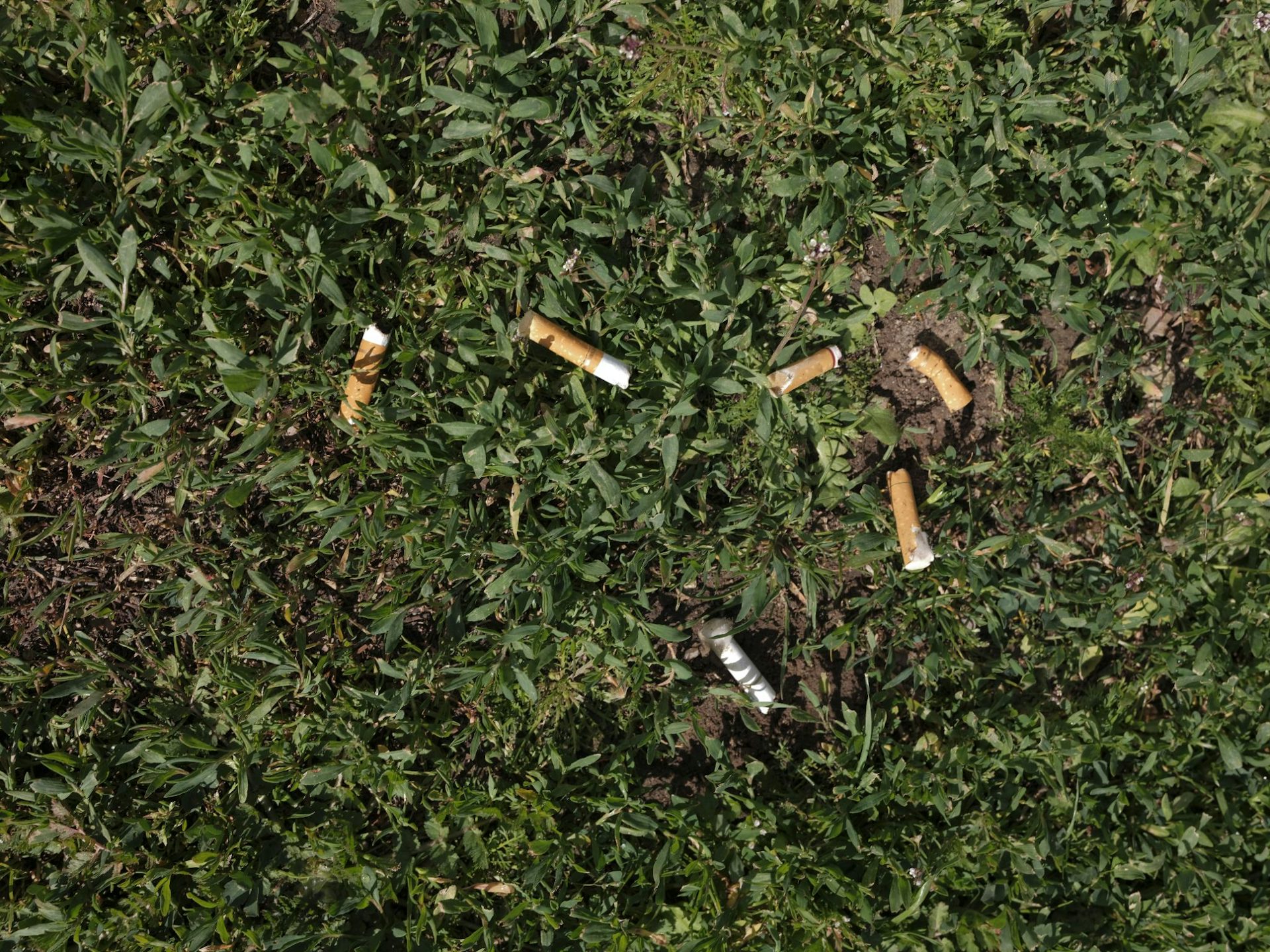The tobacco industry is a top global plastic polluter

Cigarette butts are made of microplastics
You probably see one of the most common sources of microplastics everyday – on the ground, in parking lots, in gutters, or at the beach – cigarette butts.1 Discarded cigarettes contain filters made of plastic, which can break down into microplastics that then contaminate our soil and water sources and harm our health.2 In fact, each cigarette filter contains at least 15,000 strands of microplastic fibers.3
Cigarette butts are a major source of plastic pollution that endanger marine life and may harm humans.4 Each year, cigarette butts are the most discarded item in the United States, which makes sense – Big Tobacco makes 6 trillion cigarettes each year, making them a top global plastic polluter.567
What exactly are microplastics, and why should we care?
Microplastics are tiny pieces of plastic measuring less than five millimeters long, about the size of a sesame seed or smaller.8 Though often invisible to the human eye, microplastics are nearly everywhere – polluting the food we eat, the water we drink, and even the air we breathe.910 Most microplastics take a long time to degrade in the environment, which means that when they enter our environment, they may eventually get eaten by marine life or other animals, which over time may go on to harm entire ecosystems.1112
Due to their tiny size, microplastics are challenging to remove from our food and water sources.13 Microplastics have been found in sea water, tap water, and urban water runoff.14157 It may come as a surprise that Americans ingest an estimated hundreds of thousands of microplastic particles a year.16 According to recent studies, microplastics have been found in human lungs, breast milk, and blood; they’ve been linked to fertility issues, oxidative stress, and inflammation in humans.1718192021222324
There’s no denying that tobacco product waste produces massive plastic pollution causing irreparable damage to our environment, our food supply, and potentially our bodies.
Written by Scott Coffin, Research Scientist
California State Water Resources Control Board
- NOAA. What is the most common form of ocean litter? National Ocean Service website, https://oceanservice.noaa.gov/facts/most-common-ocean-litter.html, 01/20/23.
- Novotny TE, Lum K, Smith E, Wang V, Barnes R. Cigarette butts and the case for an environmental policy on hazardous cigarette waste. Int J Environ Res Public Health. 2009; 6(5): 1691-1705. doi:10.3390/ijerph6051691
- Belzagui F, Buscio V, Gutiérrez-Bouzán C, Vilaseca M. Cigarette butts as a microfiber source with a microplastic level of concern. Sci Total Enviro. 2021;762:144165. doi:10.1016/j.scitotenv.2020.144165
- Novotny TE, Lum K, Smith E, Wang V, Barnes R. Cigarette butts and the case for an environmental policy on hazardous cigarette waste. Int J Environ Res Public Health. 2009; 6(5): 1691-1705. doi:10.3390/ijerph6051691
- Ocean Conservancy, International Coastal Cleanup. 2022 Report: Connect + Collect. Washington, DC: Ocean Conservatory, International Coastal Cleanup; 2022. Accessed April 10, 2023.
- Novotny TE, Slaughter E. Tobacco product waste: an environmental approach to reduce tobacco consumption. Curr Environ Health Rep. 2014;1(3):208-216. doi:10.1007/s40572-014-0016-x
- Break Free From Plastic. Branded Vol. III: Demanding Corporate Accountability for Plastic Pollution. 2020. Accessed April 10, 2023.
- California State Water Resources Control Board, Resolution No. 2020-0021: Adoption of Definition of ‘Microplastics in Drinking Water.’ Published June 16, 2020. Accessed April 12, 2023.
- Zarus GM, Muianga C, Hunter CM, Pappas RS. A review of data for quantifying human exposures to micro and nanoplastics and potential health risks. Sci Total Environ. 2021;756:144010. doi:10.1016/j.scitotenv.2020.144010
- Prata JC. Airborne microplastics: consequences to human health? Environ Pollut. 2018;234:115-126. doi:10.1016/j.envpol.2017.11.043
- Chamas, Ali, Hyunjin Moon, Jiajia Zheng, Yang Qiu, Tarnuma Tabassum, Jun Hee Jang, Mahdi Abu-Omar, Susannah L. Scott, and Sangwon Suh. 2020. “Degradation Rates of Plastics in the Environment.” ACS Sustainable Chemistry & Engineering 8 (9): 3494–3511.
- Everaert G, De Rijcke M, Lonneville B, et al. Risks of floating microplastic in the global ocean. Environ Pollut. 2020;267:115499. doi:10.1016/j.envpol.2020.115499
- Padervand M, Lichtfouse E, Robert D, Wang C. Removal of microplastics from the environment: a review. Environ Chem Lett. 2020;18:807-828. doi:10.1007/s10311-020-00983-1
- Choy CA, Robison BH, Gagne TO, et al. The vertical distribution and biological transport of marine microplastics across the epipelagic and mesopelagic water column. Sci Rep. 2019;9:7843. doi:10.1038/s41598-019-44117-2
- Moran K, Miller E, Mendez M, et al. A Synthesis of Microplastic Sources and Pathways to Urban Runoff. SFEI Technical Report: SFEI Contribution # 1049. Richmond, CA: San Francisco Estuary Institute; 2021.
- Mohamed Nor NH, Kooi M, Diepens NJ, Koelmans AA. Lifetime accumulation of microplastic in children and adults. Environ Sci Technol. 2021;55(8):5084-5096.
- Pauly JL, Stegmeier SJ, Allaart HA, et al. Inhaled cellulosic and plastic fibers found in human lung tissue. Cancer Epidemiol Biomarkers Prev. 1998;7(5):419-428.
- Jenner LC, Rotchell JM, Bennett RT, Cowen M, Tentzeris V, Sadofsky LR. Detection of microplastics in human lung tissue using μFTIR spectroscopy. Sci Total Environ. 2022;831:154907. doi:10.1016/j.scitotenv.2022.154907
- Ragusa A, Notarstefano V, Svelato A, et al. Raman Microspectroscopy Detection and Characterisation of Microplastics in Human Breastmilk. Polymers (Basel). 2022;14(13):2700. doi: 10.3390/polym14132700.
- Leslie HA, van Velzen MJM, Brandsma SH, Vethaak D, Garcia-Vallejo JJ, Lamoree MH. Discovery and quantification of plastic particle pollution in human blood. Environ Int. 2022;163:107199. doi:10.1016/j.envint.2022.107199
- Xie X, Deng T, Duan J, Xie J, Yuan J, Chen M. Exposure to polystyrene microplastics causes reproductive toxicity through oxidative stress and activation of the p38 MAPK signaling pathway. Ecotoxicol Environ Saf. 2020;190:110133. doi:10.1016/j.ecoenv.2019.110133
- Hou J, Lei Z, Cui L, et al. Polystyrene microplastics lead to pyroptosis and apoptosis of ovarian granulosa cells via NLRP3/Caspase-1 signaling pathway in rats. Ecotoxicol Environ Saf. 2021;212:112012.
- Rubio L, Barguilla I, Domenech J, Marcos R, Hernández A. Biological effects, including oxidative stress and genotoxic damage, of polystyrene nanoparticles in different human hematopoietic cell lines. J Hazard Mater. 2020;398:122900. doi:10.1016/j.jhazmat.2020.122900
- Coffin S, Bouwmeester H, Brander S, et al. Development and application of a health-based framework for informing regulatory action in relation to exposure of microplastic particles in California drinking water. Microplast nanoplast. 2022;2(1):12. doi: 10.1186/s43591-022-00030-6.
Explore by topic
